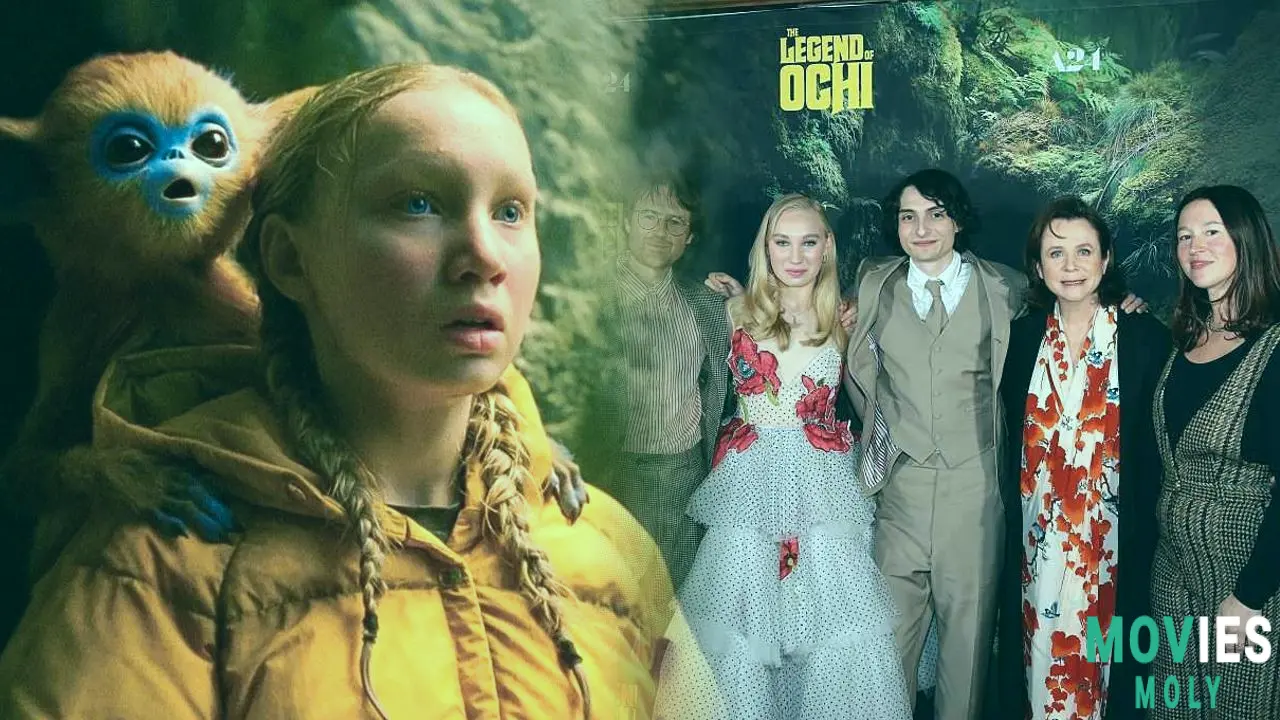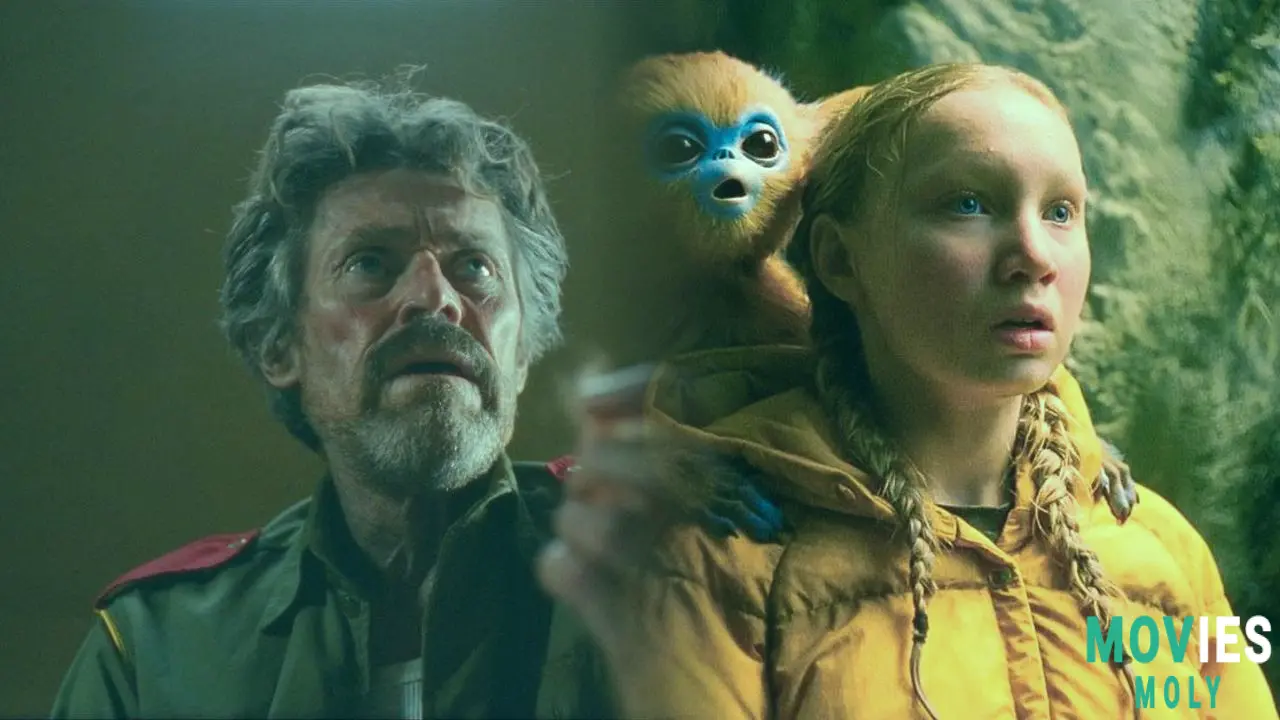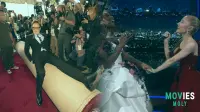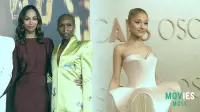There are actors who seem to exist in cinema not merely to tell stories, but to transform the very atmosphere of a film. Willem Dafoe is unquestionably one of those forces. From the dank corridors of the Green Goblin’s lair to the storm-lashed isolation of a two-man lighthouse, Dafoe has continually mined the space between intensity and vulnerability. His latest turn in A24’s The Legend Of Ochi—the fantastical, retro-spirited fable by Isaiah Saxon—adds yet another dimension to his ever-evolving arsenal.
Dafoe’s Maxim is a Mythic Villain-Through-Human-Eyes in a Fairytale WorldSet on the woodsy, old-world island of Carpathia, The Legend of Ochi follows a teenage girl, Yuri (Helena Zengel), on a colorful and sometimes grim quest to return a wounded baby Ochi—a strange, primate-like creature—to its family. Dafoe’s Maxim, Yuri’s father, is a hunter of the Ochi and leader of a militarized troupe of boys trained to exterminate the creatures. Clad in anachronistic Viking armor, brandishing spears instead of guns, Maxim is as visually discordant as he is emotionally combustible.
But what makes Maxim more than just another fantasy-genre antagonist is Dafoe’s masterful layering of the character. He gives Maxim a familiar rhythm—one that echoes through Dafoe’s past roles like a signature motif. Think of the fervent edge of Thomas in The Lighthouse, the moral mania of Paul in The Boondock Saints, or the unhinged precision of Geiger in Speed 2. Yet here, Dafoe tempers the madness with a glimmer of paternal confusion and, ultimately, transformation. Maxim isn’t just battling the Ochi. He’s grappling with his own worldview—and with a daughter he doesn’t know how to see.
Practical Effects and Costume Design Fuel Dafoe’s Immersive Performance

Dafoe has often spoken about how practical effects ground him as a performer, and The Legend of Ochi is nothing if not a love letter to tactile filmmaking. Puppetry, matte paintings, and handcrafted visuals replace CGI with soul. In this analog wonderland, Dafoe’s armor doesn’t just protect Maxim—it isolates him. The full helmet, the heavy breastplate, the medieval grandeur stuck in a rustic fantasy world—it’s a costume that creates emotional distance, even as the character longs for connection.
“When you have a good costume, the costume tells you what to do,” Dafoe said in a recent interview. And it shows. Maxim’s gear is gloriously out of place, giving Dafoe the room to play a man who is not only leading a fear-based crusade but also clinging to a mythology of masculinity and control. It’s a striking visual metaphor for a character who is, by the end of the film, forced to shed his armor in more ways than one.
Dafoe Transforms Fear-Mongering into a Journey Toward Enlighenment
At first, Maxim appears as a classic archetype: the domineering father, the hunter, the believer in human supremacy over nature. But Isaiah Saxon’s script, combined with Dafoe’s nuanced delivery, turns this archetype into a study of radicalization and redemption. Maxim sells fear to the boys under his command, but he also speaks to their pain. He isn’t a one-dimensional villain—he’s a human being trapped in a cycle of belief and emotion.
“You may think me nasty and grim, but remember my dears... I know your pain,” Dafoe’s Maxim says in a moment that reeks of both manipulation and melancholic honesty. It’s the kind of line that could easily slip into camp, but Dafoe grounds it with a sense of lived experience. Maxim’s journey mirrors Yuri’s in a twisted way: both are seeking understanding, but from different starting points. And by the end, Maxim doesn’t just gain empathy—he gains a new way of seeing.
Wonder Is Dafoe’s Ultimate Weapon Against Cynicism and Functionality
For a film so steeped in fantasy, folklore, and colorful carnage, Dafoe’s most profound contribution might be his embrace of wonder. The concept isn’t just thematic—it’s existential. Dafoe, now also the Artistic Director for the Venice Biennale’s International Theater Festival, describes wonder as “a way to challenge your conditioned responses to things.” It’s about breaking free from function and meaning, and returning to the essence of experience.
In a world where Maxim clings to fear as a tool, Dafoe’s performance invites us to see what happens when that fear is replaced by awe. When Yuri takes care of the baby Ochi, she’s not just saving a creature—she’s sparking a transformation in a world that’s forgotten how to look closely at what’s alive around it. Dafoe calls this “living moment by moment,” and it’s a throughline in his career—a throughline that now runs straight into the heart of The Legend of Ochi.
Dafoe’s Role in The Legend of Ochi Is Another Layer in a Career Built on Emotional Alchemy
Willem Dafoe has never shied away from roles that ask him to exist in extremes. But what separates him from mere genre operators is his ability to find the emotional core in those extremes. In The Legend of Ochi, he doesn’t just play a hunter of mythical creatures—he becomes a hunter of perception, a man who learns to see beyond fear, beyond control, beyond the armor he wears.
This is the kind of performance that doesn’t just elevate a film—it enriches a career. A career that continues to explore not just what it means to be human, but what it means to wonder as a human. And in that exploration, Dafoe once again proves he’s not just surviving in the fantastical—he’s thriving in it.





